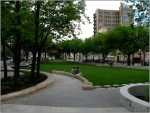A Placemaking Journal
Love Ain’t Enough: Put Up or Shut Up
Like any next, big something, placemaking is growing up. And in its role as gawky adolescent, it’s beginning to realize something most of us have long since come to accept: You can’t skirt by on youthful good looks forever.
Today, efforts to create more endearing and enduring surroundings are being subjected to decidedly grown up demands. And with them, smart growthers—from enviros to designers to code reform advocates—are learning one of life’s hardest lessons: Love will only take you so far.
Son, you’ve got to demonstrate sufficient returns.
Recently, a city asked me for some help in their argument for funding transit oriented developments with TIFF dollars. The top arguments that immediately came to mind are the same reasons that cities are investing in planning and zoning reform, even during these tight times. City planning is able to speak to a variety of the significant challenges that currently face us. Here’s the soundbite version of the top 4 drivers.
How do walkable neighbourhoods contribute to the local economy? They increase long term asset value for many reasons, including increased housing value, less crime, higher walkscore, lower vehicle miles traveled, less carbon emissions, fewer auto costs, greater personal fitness, decreased infrastructure cost, more hours available, real community, and the list goes on.
What does obesity cost, and how is it effected by where I live? The average white male living in a compact community weighs 10 pounds less than his counterpart in a low density subdivision, according to the British Columbia School of Planning. Every 1% rise in the urban sprawl index increases the risk of obesity by 0.5%, according to Boston University School of Public Health. The medical costs to treat obesity in the US for 2008 is estimated at $147 billion.
How much more does sprawling infrastructure cost, over traditional compact patterns of development? An EPA study indicates compact infrastructure is up to 47% less expensive than conventional development patterns. Calgary estimated compact development will save them $11 billion in infrastructure costs, making it 33% less costly to build the roads, transit, water, recreation, fire, and schools that it expects to need over the next 60 years.
Walkable communities can quell the effects of global warming and peaking oil with mixed use, compact urban design. An average family in auto-dependent community drives 24,000 miles per year, while a family in a walkable community of 16 dwelling units per acre and compact mixed use drives 9,000 miles per year, according to Sustainable Urbanism. The average American churns out 20 metric tons of CO2 per year; Manhattan resident 7 metric tons. The Transportation Research Board’s “Driving and the Built Environment” details the effects of land development patterns and vehicle miles traveled (VMT) on petroleum use and greenhouse gas (GHG) emissions. Doubling residential density while increasing nearby employment, transit, and mixed use can decrease VMT by 25%, along with reductions in energy consumption and GHGs.
According to my calculations, the emissions profile for the US plus Canada indicates that residential uses generate 24% of our CO2, commercial 21%, transportation 40%. On the energy side, residential burns 21% of our total energy, commercial 18%, transportation 29%. These numbers don’t include industrial, because they experience less of an impact from urbanism. LEED buildings clearly aren’t enough to solve our energy and emission challenges, because transportation uses the majority of energy and generates the most emissions. And these numbers skew upward locally in the more auto-centric places.
Sustainable urbanism strategy changes energy demand, efficiency and generation. Decreasing demand via transit-rich compact development patterns, increasing efficiency with high performance infrastructure and green architecture, and increasing generation with renewable energy sources, on-site generation, district energy, and integrated agriculture.
It makes sense to invest in the proven harbingers of change. Those that are tested to produce local mission statements about what we all want, and not a bevy of unintended consequences. Those that form the basis of a real community that can leave our children with a hopeful future.
—Hazel Borys













